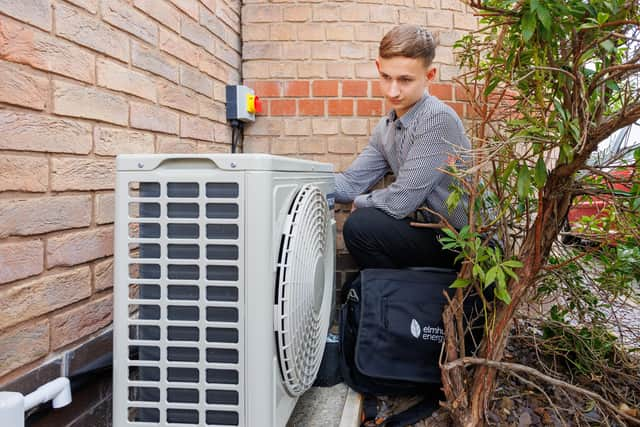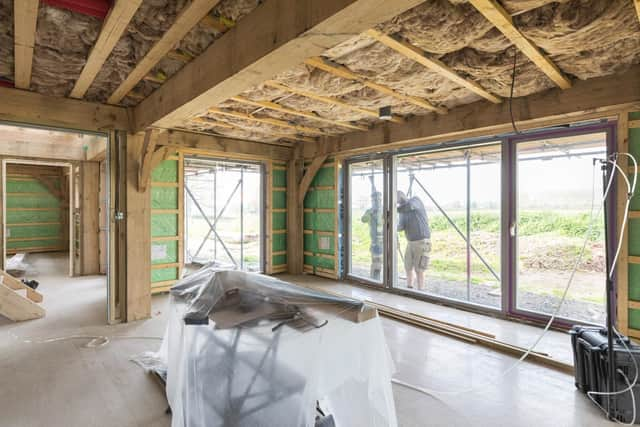From insulation to draught-proofing: An experts’ guide to making your home more energy-efficient for a net-zero Scotland
Scotland is leading the charge towards a climate-friendly society, aiming for net zero emissions by 2045 – five years ahead of the UK’s 2050 target.
But with greenhouse gas levels currently going in the wrong direction and the most recent reductions target missed, this will be a tough challenge that requires major changes to the way we live – and the homes we live in.
Advertisement
Hide AdAdvertisement
Hide AdThe residential sector has a major impact on the environment, responsible for nearly a sixth of Scotland’s total greenhouse gas emissions – mainly due to high use of fossil fuels for heating.
To meet the 2045 net zero target, energy use in all buildings will have to be significantly lowered.
Most of the country’s 2.5 million households currently use mains gas, while just 278,000 – around 11 per cent – employ a renewable or low-carbon system.
“The move to low-carbon heating is an essential part of the UK reaching its net zero targets and Scotland delivering its commitment to make buildings zero carbon by 2045,” said Joanna O’Loan, knowledge manager at the Energy Saving Trust, which operates government-funded advisory service Home Energy Scotland.
Holyrood has already announced that direct-emissions heating systems will be banned in all new buildings from next year, while Westminster is aiming for all traditional boilers to be replaced with low-carbon alternatives at the end of their life from 2035.


The Scottish Government has also declared it will introduce regulations requiring that all residential properties in the country achieve an Energy Performance Certificate (EPC) rating of C or equivalent by 2033, where technically and legally feasible and cost-effective.
But while energy-efficiency is improving, around 1.4 million Scottish households are still rated below C.
All homes are not equal, with some more difficult to bring up to modern standards.


Advertisement
Hide AdAdvertisement
Hide AdThe nation’s existing housing stock – up to 2.5 million homes – is diverse, much of it pretty old.
Around 112,000 detached houses and 187,000 tenement flats were constructed prior to 1919, and terraced houses and semis built in the post-war period from 1945 to 1982 account for about a fifth of all homes in Scotland.
Then there are newer abodes – 253,000 detached houses and 139,000 more modern tenements – which went up from 1982 onwards.
What they all have in common is that over the coming years they will need upgrading to comply with Scotland’s earth-friendly future.


So what does this actually mean for the average householder?
Most people will likely eventually get rid of fossil fuel central heating systems and switch to greener electric options.
However, the scale of these changes means the shift is likely to be slow.
In the meantime, there are a number of other measures that will not only green up the average dwelling but will also save money in the long run.
Advertisement
Hide AdAdvertisement
Hide AdHere we present an experts’ guide to upgrading older homes while explaining what you can expect in a new-build.


This old house
Retrofitting older buildings presents challenges but the key advice from experts is to get the basics right first.
Insulation can make a big difference.
“Draught-proofing and insulating your home well are both worth doing, whatever type of heating system you have,” O’Loan said.
“This is because reducing heat loss will mean less energy is needed to keep your home warm.”
Fairlie added: “It’s pointless investing in a heat pump if you haven’t addressed heat-loss around the rest of the home first.
“Make sure you draught-proof rooms and insulate well.
“Even little things like making sure your external doors don’t have a gap letting in cold air make a difference.”
Traditional tenement blocks
According to Scottish Government research, traditional tenement flats emit 5.6 tonnes of carbon each year, compared with 3.6 tonnes for those built after 1982.
Highland and island Scots could ‘freeze or starve’ as remote homes face highest bills
Advertisement
Hide AdAdvertisement
Hide AdPlanning constraints often mean that adding external wall insulation is not allowed on the frontage of buildings.
Similarly, adding solar panels to the roof can be a no-go due to heritage requirements. For the most part, window dimensions must be retained.
Despite these constraints, Stuart Fairlie, managing director of assessment and retrofit training provider Elmhurst Energy, says there are other “hugely effective” measures to take.
“Loft insulation will make one of the biggest, immediate cuts to bills and probably pay for itself in less than two years,” he said.
“Another energy-saving tip is simply to get to grips with your thermostat and program it correctly, using a consistent temperature – one for day, one for night.
“Dropping by just one degree can slash 10 per cent off a bill.”
New-builds
The key to energy-efficiency is to put in the effort early to make sure the fabric is airtight so that heat pumps and mechanical ventilation can work efficiently.
Hugh Franklin, head of sealant specialist AeroBarrierUK, said: “For residents and homeowners better air-tightness levels reduce energy bills and create healthier living conditions.
Advertisement
Hide AdAdvertisement
Hide Ad“Only then will heat pumps and controlled ventilation be effective.”
Damp and mouldy homes
In Edinburgh alone, the number of people living with damp and mould has shot up by 895 per cent.
Solving that problem is crucial before retrofitting.
Luke Smith is managing director at Build Test Solutions, which has developed tech that can predict mould forming while also assessing a building’s thermal performance.
He stresses the importance of identifying risks and taking preventative action where possible.
“Doing so could not only prevent people having health problems but also save lives,” he said.
“We must recognise all homes are unique and that any worthwhile investment in home-improvement should always start with measuring and understanding the property.”
Householders in Scotland may be eligible for grant and interest-free loans for a range of home improvements, including heat pumps. Advice is available from Home Energy Scotland.
Comments
Want to join the conversation? Please or to comment on this article.